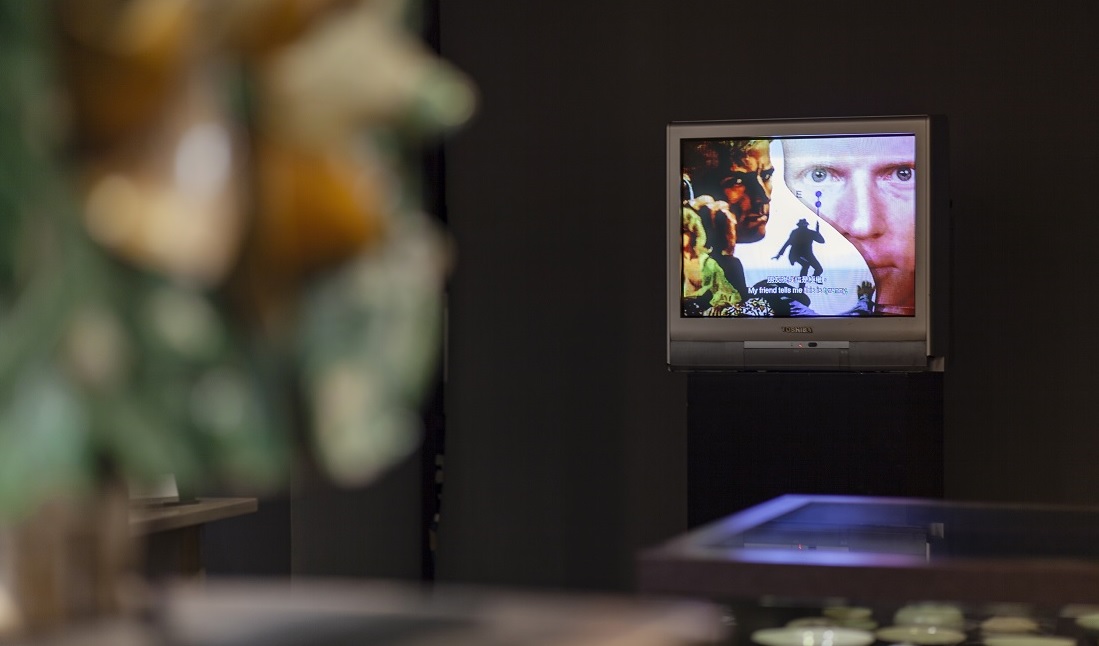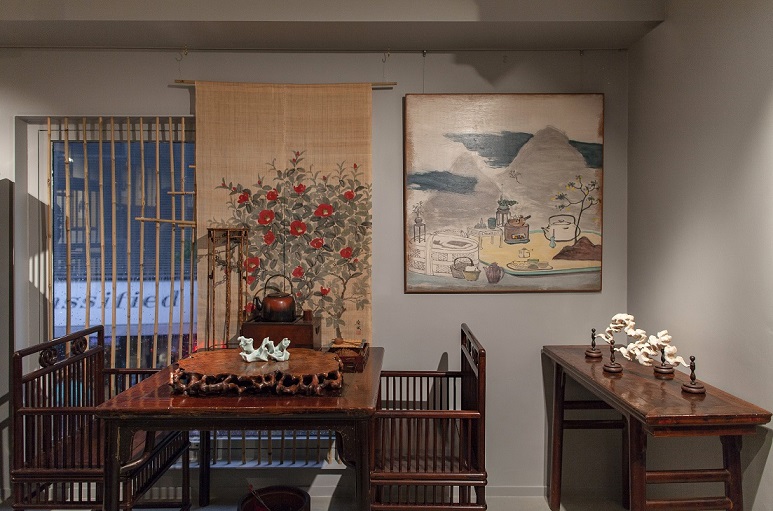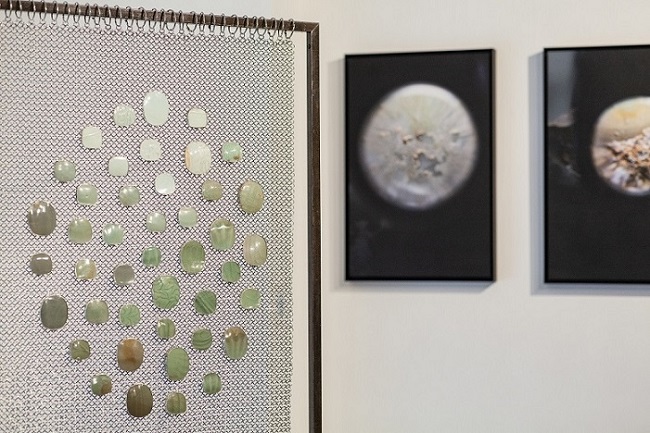Invited Writers
This new section on the AICAHK website supports young Hong Kong writers. The latest articles by invited writers are below. Other articles by invited writers can be read by clicking on the 'Archive' year and month on the side-bar.
Review: Up Close Hollywood
Daniel Szehin HO
at 3:30am on 28th July 2020





圖片說明:
1. 陳翊朗,《八腕目》,單頻錄像,乾馨唐
2. 陳麗同,《現在遺跡》系列,乾馨唐
3. 劉學成,《巖封》、《匣嶽》,瀚明
4. 林東鵬,《紅拂記(六)、(七)》,瀚明
5. 林東鵬,《飲茶圖 (一)》、劉學成《雲欄(一)、(二)》,如壹藝術館
照片由主辦者提供
Captions:
1. Oscar Chan Yik Long, “Octopoda”, 2020, Single-channel video, Bonnie Lai Antiquities
2. Leelee Chan, “Present Relics” series, 2020, Bonnie Lai Antiquities
3. Lau Hok Shing, “Revisiting Qi Quan Zhai: A Tale of Isolation” series, 2020, Hon Ming Gallery
4. Lam Tung Pang “The Tale of Red Whisk #6, #7”, 2020, Acrylic and charcoal on plywood, Hon Ming Gallery
5. Lam Tung Pang, “Tealegram #1”, 2020, Acrylic and charcoal on plywood; Lau Hok Shing, “Revisiting Qi Quan Zhai: A Tale of Isolation” series, 2020, Gallery 149
Photos courtesy of the organisers
(原文以英文發表,評論「走近 – 荷李活道」展。)
“It feels almost unseemly for someone working in contemporary art to have too much of an interest in antiquities and classical art,” a writer-friend once said to me, before adding, noticing my winces, “I, too, am becoming more interested in older things—with age.” A jest though this may be, rarely are interests all-compassing, and fierce biases emerge in the narrowest of spheres. After all, you don’t exactly expect someone to relish, say, Fotan Laiki’s trap rap, 1930s jazz/folk songs of old Shanghai, and Baroque operas with equal fervour, while aficionados of Renaissance architecture often turn their nose up at Tropical Modernism and express horror at Brutalism (and vice versa). The Quarrel of the Ancients and Moderns pops up in unusual places, and so it was with some uncertainty I approached “Up Close Hollywood”, curated by Hilda Chan 陳芍君 and Iven Cheung 張耀輝 (and co-initiated with Leelee Chan). This contemporary art project inserted contemporary artworks into four antique stores on Hollywood Road, Hong Kong, offering up an experience “at once familiar and remote” (1) to those more familiar with contemporary art.
A little embarrassingly, I must confess I had rarely paid a visit to the purveyors of antiquities in the area, despite having often scrambled up and down its streets. I can chalk it up to neglectful disinterest and blithe carelessness, but then again, are these places really eager to see plebs like me, instead of collectors? The “by appointment only” indication for this project seemed like an extra hurdle—though it turned out the simpler reason was antique dealers’ rather leisurely schedules. In any case, the tables have turned, and I got a taste of what some feel about the contemporary art world, with its particular rituals of openings and dinner invites and what not. I thus ventured forth and hoped at least for a fruitful anthropological or sociological undertaking. In the end, three points came up over and over in my mind: the variety of display practices, the range of objects, and the necessary reckoning with the notion of “art”.
Works by five contemporary artists (Leelee Chan 陳麗同, Oscar Chan 陳翊朗, Lam Tung Pang 林東鵬, Lau Hok Shing 劉學成, and Bing Lee 李秉罡) were displayed in the four venues in this antiques district. Gallery149 如壹藝術館 feels the most familiar, being the most “museum-like” in presentation—though you wouldn’t tell from the narrow entrance and floorplan, since the gallery stretches four or five storeys upward, accessible by one of the daintiest lifts in Hong Kong. With a fairly generous amount of space, the themed rooms here feel at times like a well-appointed home and at other times like a display in a historical museum. Lam Tung Pang’s acrylic and charcoal reinterpretation of the literati tradition (“Tealegram #1”, 2020) and Lau Hok Shing’s miniature “cloud sculptures” (“Revisiting Qi Quan Zhai: A Tale of Isolation” series, 2020), both finely wrought, sat prettily in a tearoom setting, where your attention cannot help but wander towards various curios and the rough yet artfully hewn teaware from Japan. Another of Lau Hok Shing’s pieces, small and minimal with the slightest vegetative curves, stood its ground in a room with jaw-dropping Buddhist statues and busts from Southeast Asia and Tibet (one can only wonder at the provenance). In yet another room, Leelee Chan had reconfigured ceramic shards from the Song to Ming dynasties onto a steel chain mail in an experimentation with materiality and form (“Celadon Weaver”, 2020), while her “Surface Morphology” (2020) presented photographs which foregrounded the connoisseur’s gaze through a magnifying glass onto the surface of ceramics. While the former felt a bit decorative for my taste, the latter stirred greater interest, perhaps due to its exploration and excavation of the details of antiques appraisal.

Leelee Chan “Celadon Weaver”, 2020, Ceramic shards (Qingbai ware, Longquan ware and Yaozhou ware) from Song to Ming dynasties (10th to 17th centuries AD), 925 silver, stainless steel chain mail and steel stand; Leelee Chan “Surface Morphology”, 2020, Archival pigment prints, Gallery 149. Photo courtesy of the organiser.
陳麗同,《青瓷編織者》、《黏砂 明代龍泉窯青瓷》、《土沁 宋代龍泉窯青瓷》,如壹藝術館。照片由主辦者提供。
Lam Tung Pang and Lau Hok Shing’s works could also be found at Hon Ming 瀚明—which specialises in fine classical Chinese furniture dealing and restoration—with Lam reinterpreting Hongfuji 紅拂記, a Ming-dynasty drama, and Lau playfully presenting his miniature sculptures in various forms of literati displays and forms (glass cases, aged little boxes, books). In particular, Lau experimented with forms of scholarly rocks and landscapes, in some cases counterposed with geometric shapes (spheres, circles), conveying a sense of precariousness which supposedly reflects the precarity of the present condition in Hong Kong. Beguiling though these may be, I could not help but think of what the critic Li Xiaoshan 李小山 said in 1985, of Chinese literati art having reached a “dead end” (窮途末日): can we really continue digging at the emptied mine of literati ideals, hallowed though they may be? Can we truly carry on with permutations of “ink”, “brush”, “landscapes”, “scholarly rocks”, however experimentally and innovatively, and tackle the aesthetic, intellectual, and political questions of the age—without falling into (seeming) hermetic withdrawal, or worse, kitsch? True, the criticism here is in the vein of an iconoclastic “May Fourth” ideal; I cannot help but be biased.
Such thoughts quickly got muffled in the bric-a-brac displays in Wing Hing Co 永興行, filled with curios of all types: scholar’s objects, snuff bottles, pipes, and ivory—complete with certificates attesting that the ivory had been procured prior to the convention banning the trade. The intense vibe of obsessive collecting is paired with the somewhat banal practice of display akin to what one might see in computer centres in Mong Kok; the premium is on the efficient use of space. You thus see objects packed in one after the other, in a very “Hong Kong” version of cabinets of curiosity. In this treasure hunt of sorts—in this store but indeed also throughout the whole project—you can spy in one cabinet space Bing Lee’s “Museum of Obscure Objects” series (2020), a fictive collection by a fictitious collector (some of Lee’s works by the “collector” was also presented in Gallery149). The New York–based artist of Hong Kong origin created objects that look very much like opium paraphernalia (pipes, lamps, bowls), all of which also happen to be a specialty at Wing Hing Co.
One of the most impressive stores was Bonnie Lai Antiquities, specialising in funerary objects, terracotta sculptures and pottery, among others, with the dignified statues jutting out like historic mannequins in a sepulchral array—jostling for attention, in a good way. Amongst ancient relics from the Shang dynasty (circa 1600–1046 BC) and more recent upstarts from later dynasties is Leelee Chan’s “Present Relics” series (2020). Hailing from a family of antique dealers, Chan has intimate personal experience with antique objects, and she deftly recombined broken pieces of pottery figures with everyday objects like seashells, the metallic head of hammers, stone tiles, and so on. These figurines were once funerary objects, meant for the afterlife, and while they reflected the culture and society of a particular time, they were not realistic, mimetic representations of reality but rather offered up an ideal—the ideal official, the ideal attendant, the ideal afterlife. Her playful twists subverted the original funereal intent, and with humour cracked open new ways through which one re-imagines and re-invents the past—they also felt particularly suited to the venue.
Artists have long reinterpreted classical traditions for the present, from faithful replicas to more subversive interventions like René Magritte’s “Les Menottes de Cuivre” (2) andSalvador Dali’s “Venus de Milo with Drawers” (3) , or even Xu Zhen’s “Eternity” (4) series, among many others. Such latter appropriations usually involve (cheap) replicas of the originals. In a slightly different vein, Duchampian readymades employed mass produced objects to transgress museum conventions and notions of “art” and the “beautiful”. With “Present Relics”, the “readymades” involve, however, ancient figurines created for a ritual purpose, and then re-surfaced in a world and a market where they were probably worth something, but due to damage and fracturing have come to be considered too “ugly” and too broken to restore. And now such objects are re-enchanted with a new magic of making. The transmutation from ritual object, to commodity, to junk, and back to art highlights how despite an aspiration to the illusion of permanence, such objects are ever volatile, with their objecthood fragile, constantly in question, constantly in movement. As Arjun Appadurai has noted, “Thus, today’s gift is tomorrow’s commodity. Yesterday’s commodity is tomorrow’s found art object. Today’s art object is tomorrow’s junk. And yesterday’s junk is tomorrow’s heirloom.” (5) The power of this work lies not only in the formal skill in making but also in its celebration of the trajectory of change and transfiguration to which all artworks (and things and beings) are subject.
Another droll yet thoughtful work in the same space was “Octopoda” by Oscar Chan, a Hong Kong artist who has quite recently relocated to France with his partner. Composed of photographic stills of the artist’s second-hand knick-knacks, curios, and furniture in his Parisian home, to which the artist added sketches of his own on top, the video is a thoughtful rumination on relationships and tensions therein, heightened by a move half way around the world and bracketed by two important people in his life, at two extremes—his partner and his mother. The stills pose a slightly oppressive sense of being, and like the title reflects the artist’s psychological state of feeling he has adapted passively and reactively to the surrounding environment, like an octopus. Weighing up everyday tensions and ripostes between an Apollonian sense of order and propriety (the artist) and a Dionysian sense of revelry (the partner), the video segues into a touching self-reflection of his own personal anxieties and how the artist has somehow—inadvertently, unwillingly, and haplessly—created in himself something of his tyrannical mother, adopting her rigidities despite their problems and arguments. Amid the ancient objects in this uber-modern city, one line rang out, that of his mother, expressing an all-too-common sentiment: “Old things have to go. Preservation, conversation, all that bullshit—what is the point of keeping these old, broken, good-for-nothing things? Why not replace them with new things, fresh and bright, with all the bad energies swept away. Stop ruining your mind with those foreigners’ ideas, ‘preserving history’ and such nonsense.” The coincidence is baffling—it is nothing and everything—but on my first visit, construction on a neighbouring plot began again at this exact moment, pounding the ground with a thud, thud, thud…
(5) “The Thing Itself”, Public Culture, 18:1: 15–22, 2006.
|
|
|
|
|
|
